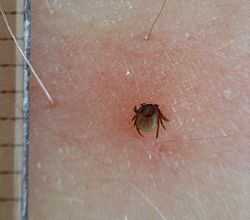Arthropod bites and stings

Editor-In-Chief: Prab R Tumpati, MD
Obesity, Sleep & Internal medicine
Founder, WikiMD Wellnesspedia &
W8MD medical weight loss NYC and sleep center NYC
| Arthropod bites and stings | |
|---|---|

| |
| Synonyms | N/A |
| Pronounce | N/A |
| Specialty | N/A |
| Symptoms | Pain, itching, swelling, redness, allergic reactions |
| Complications | Anaphylaxis, infection, Lyme disease, Rocky Mountain spotted fever |
| Onset | Immediate to several hours after bite or sting |
| Duration | Varies from hours to weeks |
| Types | N/A |
| Causes | Bites or stings from insects or arachnids |
| Risks | Outdoor activities, exposure to arthropods |
| Diagnosis | Clinical evaluation, history of exposure |
| Differential diagnosis | Cellulitis, contact dermatitis, urticaria |
| Prevention | Insect repellent, protective clothing, mosquito nets |
| Treatment | Antihistamines, analgesics, topical corticosteroids, antibiotics for secondary infection |
| Medication | N/A |
| Prognosis | Generally good with treatment, but varies with complications |
| Frequency | Common worldwide |
| Deaths | N/A |
Overview of arthropod bites and stings
Introduction[edit]
Arthropod bites and stings are common occurrences that can lead to a variety of medical conditions. Arthropods are a diverse group of invertebrates that include insects, arachnids, and crustaceans. Their bites and stings can cause reactions ranging from mild irritation to severe allergic responses.
Types of Arthropods[edit]
Insects[edit]
Insects are the most common arthropods that bite or sting humans. This group includes:
- Mosquitoes - Known for their itchy bites, mosquitoes can also transmit diseases such as malaria, dengue fever, and Zika virus.
- Bees and wasps - Their stings can cause painful swelling and, in some cases, severe allergic reactions known as anaphylaxis.
- Fleas - Flea bites can cause itching and may transmit diseases like plague and typhus.
- Bedbugs - These insects feed on human blood, causing itchy welts and discomfort.
Arachnids[edit]
Arachnids include spiders, scorpions, and ticks. Notable examples are:
- Spiders - While most spider bites are harmless, some, like the black widow and brown recluse, can cause significant medical issues.
- Scorpions - Scorpion stings can be painful and, in some cases, life-threatening, especially in children.
- Ticks - Ticks are vectors for diseases such as Lyme disease and Rocky Mountain spotted fever.
Crustaceans[edit]
While less common, some crustaceans can also cause bites or stings. For example, certain types of crabs and lobsters can pinch or sting, leading to injury or allergic reactions.
Symptoms[edit]
The symptoms of arthropod bites and stings vary depending on the type of arthropod and the individual's sensitivity. Common symptoms include:
- Redness and swelling at the site of the bite or sting
- Itching or pain
- Blistering or rash
- Fever or chills in severe cases
- Anaphylaxis in cases of severe allergic reactions
Treatment[edit]
Treatment for arthropod bites and stings depends on the severity of the reaction:
- For mild reactions, cleaning the area with soap and water, applying ice, and using antihistamines can help alleviate symptoms.
- Severe reactions, such as anaphylaxis, require immediate medical attention and administration of epinephrine.
- In cases of disease transmission, specific treatments for the disease may be necessary.
Prevention[edit]
Preventing arthropod bites and stings involves several strategies:
- Using insect repellent containing DEET or picaridin
- Wearing protective clothing, such as long sleeves and pants
- Avoiding areas with high arthropod activity, especially during peak times
- Keeping living areas clean and free of food debris to deter insects
Images[edit]


See also[edit]
Ad. Transform your life with W8MD's Budget GLP-1 injections from $75


W8MD offers a medical weight loss program to lose weight in Philadelphia. Our physician-supervised medical weight loss provides:
- Weight loss injections in NYC (generic and brand names):
- Zepbound / Mounjaro, Wegovy / Ozempic, Saxenda
- Most insurances accepted or discounted self-pay rates. We will obtain insurance prior authorizations if needed.
- Generic GLP1 weight loss injections from $75 for the starting dose.
- Also offer prescription weight loss medications including Phentermine, Qsymia, Diethylpropion, Contrave etc.
NYC weight loss doctor appointmentsNYC weight loss doctor appointments
Start your NYC weight loss journey today at our NYC medical weight loss and Philadelphia medical weight loss clinics.
- Call 718-946-5500 to lose weight in NYC or for medical weight loss in Philadelphia 215-676-2334.
- Tags:NYC medical weight loss, Philadelphia lose weight Zepbound NYC, Budget GLP1 weight loss injections, Wegovy Philadelphia, Wegovy NYC, Philadelphia medical weight loss, Brookly weight loss and Wegovy NYC
|
WikiMD's Wellness Encyclopedia |
| Let Food Be Thy Medicine Medicine Thy Food - Hippocrates |
Medical Disclaimer: WikiMD is not a substitute for professional medical advice. The information on WikiMD is provided as an information resource only, may be incorrect, outdated or misleading, and is not to be used or relied on for any diagnostic or treatment purposes. Please consult your health care provider before making any healthcare decisions or for guidance about a specific medical condition. WikiMD expressly disclaims responsibility, and shall have no liability, for any damages, loss, injury, or liability whatsoever suffered as a result of your reliance on the information contained in this site. By visiting this site you agree to the foregoing terms and conditions, which may from time to time be changed or supplemented by WikiMD. If you do not agree to the foregoing terms and conditions, you should not enter or use this site. See full disclaimer.
Credits:Most images are courtesy of Wikimedia commons, and templates, categories Wikipedia, licensed under CC BY SA or similar.
Translate this page: - East Asian
中文,
日本,
한국어,
South Asian
हिन्दी,
தமிழ்,
తెలుగు,
Urdu,
ಕನ್ನಡ,
Southeast Asian
Indonesian,
Vietnamese,
Thai,
မြန်မာဘာသာ,
বাংলা
European
español,
Deutsch,
français,
Greek,
português do Brasil,
polski,
română,
русский,
Nederlands,
norsk,
svenska,
suomi,
Italian
Middle Eastern & African
عربى,
Turkish,
Persian,
Hebrew,
Afrikaans,
isiZulu,
Kiswahili,
Other
Bulgarian,
Hungarian,
Czech,
Swedish,
മലയാളം,
मराठी,
ਪੰਜਾਬੀ,
ગુજરાતી,
Portuguese,
Ukrainian